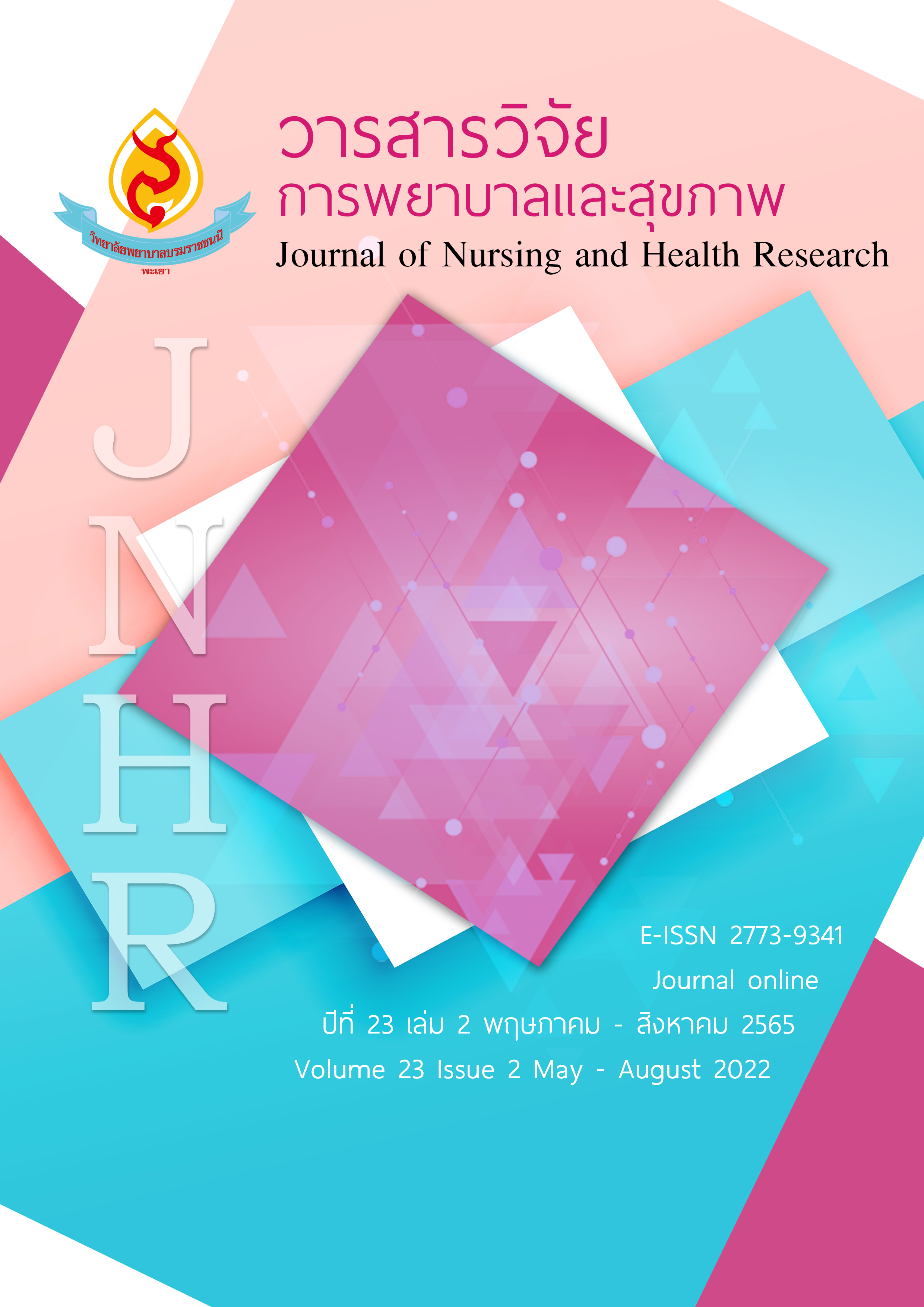ปัจจัยที่สัมพันธ์กับพฤติกรรมการป้องกันตนเองจากการติดเชื้อไวรัสโคโรนา 2019
คำสำคัญ:
พฤติกรรมการป้องกันตนเอง, โรคติดเชื้อไวรัสโคโรนา 2019บทคัดย่อ
พฤติกรรมการป้องกันตนเองจากการติดเชื้อไวรัสโคโรนา 2019 มีความสำคัญในสถานการณ์การแพร่ระบาดของโรคในปัจจุบัน การวิจัยเชิงพรรณนาแบบภาคตัดขวางครั้งนี้มีวัตถุประสงค์เพื่อศึกษาปัจจัยที่สัมพันธ์กับพฤติกรรมการป้องกันตนเองจากการติดเชื้อไวรัสโคโรนา 2019 ของประชาชน อำเภอเมืองเชียงราย จังหวัดเชียงราย กลุ่มตัวอย่าง
จำนวน 408 คน ได้จากการสุ่มกลุ่มตัวอย่างแบบหลายขั้นตอน เก็บข้อมูลระหว่างเดือนมกราคม–กุมภาพันธ์ พ.ศ. 2565
เครื่องมือเก็บรวบรวมข้อมูล ประกอบด้วย แบบสอบถามความรู้ ทัศนคติเกี่ยวกับโรคติดเชื้อไวรัสโคโรนา 2019 และพฤติกรรมการป้องกันตนเองจากการติดเชื้อไวรัสโคโรนา 2019 ผ่านการตรวจสอบความตรงเชิงเนื้อหามีค่าเท่ากับ 1.00 และมีค่าความเชื่อมั่นสัมประสิทธิ์แอลฟ่าของครอนบาค ได้เท่ากับ .73, .61 และ .76 ตามลำดับ วิเคราะห์ข้อมูล
โดยใช้สถิติ จำนวน ร้อยละ ค่าเฉลี่ย ส่วนเบี่ยงเบนมาตรฐาน การทดสอบของฟิชเชอร์ และสถิติสหสัมพันธ์แบบเพียร์สัน
ผลการศึกษา พบว่า กลุ่มตัวอย่างมีพฤติกรรมการป้องกันตนเองจากการติดเชื้อไวรัสโคโรนา 2019 อยู่ในระดับสูง
( =3.53, SD=.60) โดยปัจจัยส่วนบุคคล ได้แก่ อายุ รายได้เฉลี่ยต่อเดือน และการมีบุคคลที่มีความเสี่ยง
ต่อการติดเชื้อไวรัสโคโรนา 2019 ในครอบครัว มีความสัมพันธ์กับพฤติกรรมการป้องกันตนเองจากการติดเชื้อไวรัส
โคโรนา 2019 อย่างมีนัยสำคัญทางสถิติ (p<.05) และทัศนคติเกี่ยวกับโรคติดเชื้อไวรัสโคโรนา 2019 มีความสัมพันธ์เชิงบวกกับพฤติกรรมการป้องกันตนเองจากการติดเชื้อไวรัสโคโรนา 2019 (r=.273, p<.001) ส่วนความรู้เกี่ยวกับ
โรคติดเชื้อไวรัสโคโรนา 2019 ไม่มีความสัมพันธ์กับพฤติกรรมการป้องกันตนเองจากการติดเชื้อไวรัสโคโรนา 2019
ผลการศึกษาควรส่งเสริมให้ประชาชนมีพฤติกรรมการป้องกันตนเองจากการติดเชื้อไวรัสโคโรนา 2019 ที่ดีเพื่อป้องกันและควบคุมการแพร่ระบาดของโรคติดเชื้อไวรัสโคโรนา 2019 อย่างมีประสิทธิภาพ
เอกสารอ้างอิง
กรมการแพทย์. (2564). การดูแลรักษาผู้ป่วยโควิด-19 หลังรักษาหาย (post COVID syndrome) หรือภาวะ long COVID สำหรับแพทย์หรือบุคลากรสาธารณสุข. จาก https://COVID19.dms.go.th/Content/Select_Landding_page?contentId=157
กรมควบคุมโรค. (2564). รายงานผลการทบทวนผลกระทบเชิงเศรษฐกิจและสังคมจากการระบาดของโรคโควิด 19 ในระดับโลกและในประเทศไทย. สืบค้นเมื่อ 10 เมษายน 2565, จาก https://ddc.moph.go. th/uploads/publish/1177420210915075055.pdf
กรมควบคุมโรค. (2565). สถานการณ์ผู้ติดเชื้อ COVID-19 ภายในประเทศ. สืบค้นเมื่อ 15 เมษายน 2565, จาก https://ddc.moph.go.th/COVID19-dashboard/
จารุรัตน์ ศรีรัตนประภาส และจิราวรรณ กล่อมเมฆ. (2564). ความรู้ ทัศนคติ และพฤติกรรมการป้องกันโควิด-19 ของประชากรวัยทำงานในตำบลมวกเหล็ก อำเภอมวกเหล็ก จังหวัดสระบุรี. วารสารพยาบาลทหารบก, 23(1), 437-445.
ณัฎฐวรรณ คำแสน. (2564). ความรู้ ทัศนคติ และพฤติกรรมในการป้องกันตนเองจากการติดเชื้อไวรัสโควิด-19 ของประชาชนในเขตอำเภออู่ทอง จังหวัดสุพรรณบุรี. วารสารวิทยาลัยพยาบาลพระจอมเกล้า จังหวัดเพชรบุรี, 4(1), 33-48.
ดรัญชนก พันธ์สุมา และพงษ์สิทธิ์ บุญรักษา. (2564). ความรู้ ทัศนคติ และพฤติกรรมการป้องกันโควิด-19 ของประชาชนในตำบลปรุใหญ่ อำเภอเมือง จังหวัดนครราชสีมา. ศรีนครินทร์เวชสาร , 36(5), 597-604.
ตวงพร กตัญญุตานนท์, ธนภรณ์ ทองศิริ, อารยา พิชิตชัยณรงค์, ธันยพร กิ่งดอกไม้, สุภาพ ธรรมกุล, ภาวลิน แสนคำราง,...,ซัยนี่ บิลก่อเด็ม. (2564). ปัจจัยที่มีความสัมพันธ์กับพฤติกรรมการป้องกันโรคโควิด-19 ของนักศึกษาวิทยาศาสตร์สุขภาพ มหาวิทยาลัยหัวเฉียวเฉลิมพระเกียรติ. วารสารวิทยาศาสตร์และเทคโนโลยี มหาวิทยาลัยหัวเฉียวเฉลิมพระเกียรติ, 7(1), 8-20.
ธีระพงษ์ ทศวัฒน์ และปิยะกมล มหิวรรณ. (2563). การพัฒนาคุณภาพชีวิตทางสังคมของประชาชนและการป้องกันการแพร่ระบาดของโรคติดเชื้อไวรัสโคโรนา 2019 (COVID-19). วารสารมหาจุฬานาครทรรศน์, 7(9), 40-55.
มณฑา อุดมเลิศ, ดุจเดือน เขียวเหลือง, ปฐพร แสงเขียว, เสาวลักษณ์ เนตรชัง, รพีแพทย์ ประสิทธิ์นราพันธุ์ และสิตานันท์ ศรีใจวงศ์. (2565). ความรู้ ทัศนคติ และพฤติกรรมการป้องกันตนเองเกี่ยวกับโรคติดเชื้อไวรัสโคโรนา 2019 ของนักศึกษาพยาบาล วิทยาลัยพยาบาลบรมราชชนนีอุตรดิตถ์. วารสารวิทยาลัยพยาบาลบรมราชชนนีอุตรดิตถ์, 14(1), 78-90.
สำนักงานสาธารณสุขจังหวัดเชียงราย. (2565). รายงานสถานการณ์ โควิด-19 เชียงราย. สืบค้นเมื่อ 27 ธันวาคม 2564, จาก http://61.19.32.29/COVID19cr/web/index.php
ฮัมดี มาแย, วันธณี วิรุฬห์พานิช, และพิสมัย วัฒนสิทธิ์. (2562). ความสัมพันธ์ระหว่างความรู้และทัศนคติ กับการจัดการความปวดของพยาบาลในหอผู้ป่วยเด็กวิกฤตภาคใต้. วารสารเครือข่ายวิทยาลัยพยาบาลและการสาธารณสุขภาคใต้, 7(3), 47-57.
Al-Hanawi, M. K., Angawi, K., Alshareef, N., Qattan, A., Helmy, H. Z., Abudawood, Y., . . . Alsharqi, O. (2022). Knowledge, attitude and practice toward COVID-19 among the public in the kingdom of Saudi Arabia: a cross-sectional study. Frontiers in Public Health, doi:10.3389/fpubh.2020.00217
Al-Hussami, M., El-Hneiti, M., Bani Salameh, A., Abu Sharour, L., & Al-Hussami, R. (2021). Knowledge, attitudes, and behavior toward COVID-19 among Jordanian residents during the quarantine period of the COVID-19 pandemic: a national survey. Disaster Medicine and public Health Preparedness, 1–9. advance online publication. doi:10.1017/dmp.2021.34
Best, J. W. (1981). Research in education (4th Edition), New Delhi, Prentice Hall Of India Pvt. Ltd.
Bloom, B. S. (1964). Taxonomy of education objective: the classification of educational goals: handbook II: affective domain. New York: David Mckay.
Bloom, B.S. (1971). Handbook on formative and summative evaluation of student learning. New York: McGraw–Hill.
Krejcie, R. V., & Morgan, D. W. (1970). Determining sample size for research activities. Educational and Psychological Measurement, 30(3), 607–610.
Worldometer. (2022). COVID-19 coronavirus pandemic. Retrieved April 15, 2022, from https://www.worldometers.info/coronavirus/
ดาวน์โหลด
เผยแพร่แล้ว
รูปแบบการอ้างอิง
ฉบับ
ประเภทบทความ
สัญญาอนุญาต
ลิขสิทธิ์ (c) 2022 วารสารวิจัยการพยาบาลและสุขภาพ

อนุญาตภายใต้เงื่อนไข Creative Commons Attribution-NonCommercial-NoDerivatives 4.0 International License.



